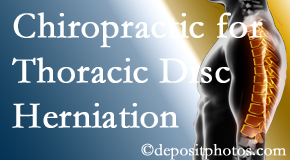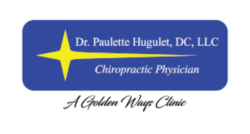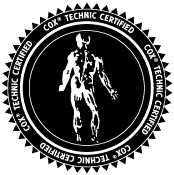La Grande Chiropractic Care for Thoracic Disc Herniation
The thoracic spine, the middle section of your spine, gets ignored. “Mid back pain” doesn’t easily roll off your tongue in quite the same way as “neck pain” and “back pain” or “arm pain” and “leg pain”. But the thoracic spine can have pain of its own. A thoracic disc herniation may be related to seemingly dissimilar conditions like irritable bowel syndrome, constipation, painful or frequent urination. Dr. Paulette Hugulet, DC, LLC does talk about the thoracic spine and its mid-back pain. Dr. Paulette Hugulet, DC, LLC gently treats the thoracic spine’s mid-back pain to successfully relieve it.
THORACIC DISC HERNIATION
The incidence of thoracic disc herniation in people who have no pain is 11-37%. It is not as rare as we think. Two studies described abdominal wall bulges: A patient later found to have a thoracic disc herniation at T11-12 on MRI imaging presented with a lateral abdominal wall bulge that shrank 8 months later as the disc herniation got better. (1) An additional two similar cases with herniations at T12-L1 and T10-11 and T11-12 had paresis of the abdominis muscle. After conservative treatment, muscle strength returned to normal in 3 to 6 months. (2) Symptoms of thoracic disc herniation can vary from abdominal pain, constipation, urinary incontinence, anesthesia or lack of anal reflex, bowel dysfunction, nausea, to irritable bowel among other issues. (3) A couple other reports describe the incidence of gastrointestinal and gastrourinary problems with thoracic disc herniations. In a study of 100 patients with thoracic disc herniation, 95% had one or more digestive-urologic symptoms, but only 3% had the diagnosis of thoracic disc protrusion. 70.76% of thoracic disc herniations occurred below the T7 level. Most were central herniations (65.25%). 85% of thoracic disc herniation patients with abdominal pain had a positive DN4 test for neuropathic pain in contrast with only 8% in the control group. 77% of the patients had abdominal pain (and 16.88% of them had gone through a surgery to relieve the pain to discover that they still have the same pain after surgery). 90% of thoracic disc pain patients report back pain, 43% have pubic pain, 35% report genital area pain, 66% have lower limb pain. (4) Thoracic disc herniation sufferers often have these issues – chronic abdominal pain, digestive issues, and urological symptoms. Another researcher reported on two patients with T10-11 herniations who displayed moderate lower extremity weakness, amplified patellar tendon reflex, and sensory disturbance of the whole lower extremities. (5) Dr. Paulette Hugulet, DC, LLC does a complete examination to determine how a thoracic disc herniation is affecting our La Grande chiropractic mid-back pain patients.
EXAMINATION
Gastrointestinal surgeons are quite likely to see patients with thoracic disc herniation as their symptoms are gastrointestinal and/or gastrourinary in nature but without any organic reason for them. A dependable test to discover whether the abdominal pain is due to issues with the abdomen or a visceral issue is Carnett’s Sign. It’s highly documented for its sensitivity of 78 to 85% and specificity of 88 to 97%. (6) It leads the examining physician to the source of pain! For La Grande patients with unexplained abdominal pain or strange abdominal wall bulges, consult Dr. Paulette Hugulet, DC, LLC who understands the connection of these issues to the thoracic disc herniation. Gentle, chiropractic spinal manipulation with Cox® Technic to the thoracic spine may help relieve pain and symptomatology of the thoracic disc herniation.
CONTACT Dr. Paulette Hugulet, DC, LLC
Listen to this PODCAST with Dr. Kurt Olding on The Back Doctors Podcast with Dr. Michael Johnson who really knows and understands the unusual but important thoracic disc herniation. Dr. Olding defines the thoracic disc herniation and its symptomatology as well as its alleviating treatment with Cox® Technic.
Schedule a La Grande chiropractic appointment at Dr. Paulette Hugulet, DC, LLC for your thoracic spine and its mid-back concerns. Dr. Paulette Hugulet, DC, LLC doesn’t overlook the thoracic spine, and you should not either!


